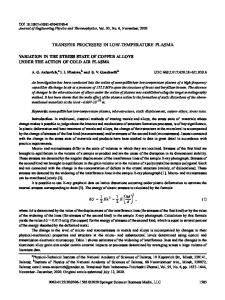Methods for the Determination of the Stress-Strain State of a Metal Under the Action of Gaseous Hydrogen and Temperature
- PDF / 1,055,649 Bytes
- 9 Pages / 594 x 792 pts Page_size
- 15 Downloads / 343 Views
METHODS FOR THE DETERMINATION OF THE STRESS-STRAIN STATE OF A METAL UNDER THE ACTION OF GASEOUS HYDROGEN AND TEMPERATURE Ya. L. Ivanytskyi,1 V. М. Boiko,1, 2 V. Z. Stankevych,3 and B. K. Hanulich4
UDC 539.4
We propose a procedure for the determination of the stress-strain state of exploited metals in gaseous hydrogen at temperature varying as a function of time. In this case, we use the principle of virtual work adapted for the quasistatic equilibrium equations with step-by-step formulation in time. The increments of displacements, hydrogen concentration, temperature, strains, and stresses for a certain small time interval are determined by using the finite-element method. To check the proposed methods, we analyze the stress-strain state of a solid finite cylinder in the atmosphere of hydrogen at temperature varying as a function of time. We consider the cases where the cylinder is unrestrained or restrained at one of its ends. Keywords: stress-strain state, hydrogen, temperature, hydrogen concentration, finite-element method, backward Euler method, finite solid cylinder.
Introduction In the process of long-term operation of structural elements, they are mainly affected by force loads and working media. In particular, in the nuclear and thermal power-generating industries structural elements operate under the conditions of thermal and force loading and under the action of hydrogen. As a result of action of these factors, the stress-strain state of the material changes, which affects its service life. The researches were mainly devoted to the analysis of the influence of mechanical stresses on the redistribution of hydrogen concentration [1–6]. The influence of changes in the hydrogen concentration on the stress-strain state of an infinite steel cylinder was investigated in [7]. However, the application of this approach to finite bodies is problematic. This is why, in what follows, we propose a procedure for the determination of the stress-strain state of structural elements operating in gaseous hydrogen under the conditions of variable temperature. Initial Equations and the Scheme of Solution of the Problem To determine the stress-strain state of the metal, we use the principle of virtual work adapted to the case of quasistatic equilibrium equations in the step-by-step formulation for the time t + Δt [8]:
∫ δ({ε}
V 1 2 3 4
T t +Δt
)
{Δσ} dV =
T t +Δt
∫ δ({ u }
Γ
)
{Δp} dΓ + ∫ δ({u}T )t +Δt {Δb} dV V
Karpenko Physicomechanical Institute, National Academy of Sciences of Ukraine, Lviv, Ukraine. Corresponding author; e-mail: [email protected].
Pidstryhach Institute for Applied Problems in Mechanics and Mathematics, National Academy of Sciences of Ukraine, Lviv, Ukraine. Lutsk National Technical University, Lutsk, Ukraine.
Translated from Fizyko-Khimichna Mekhanika Materialiv, Vol. 56, No. 2, pp. 101–108, March–April, 2020. Original article submitted October 28, 2019. 1068-820X/20/5602–0247
© 2020
Springer Science+Business Media, LLC
247
YA. L. IVANYTSKYI, V. М. BOIKO, V. Z. STANKEVYCH,
248
AND
B.
Data Loading...











